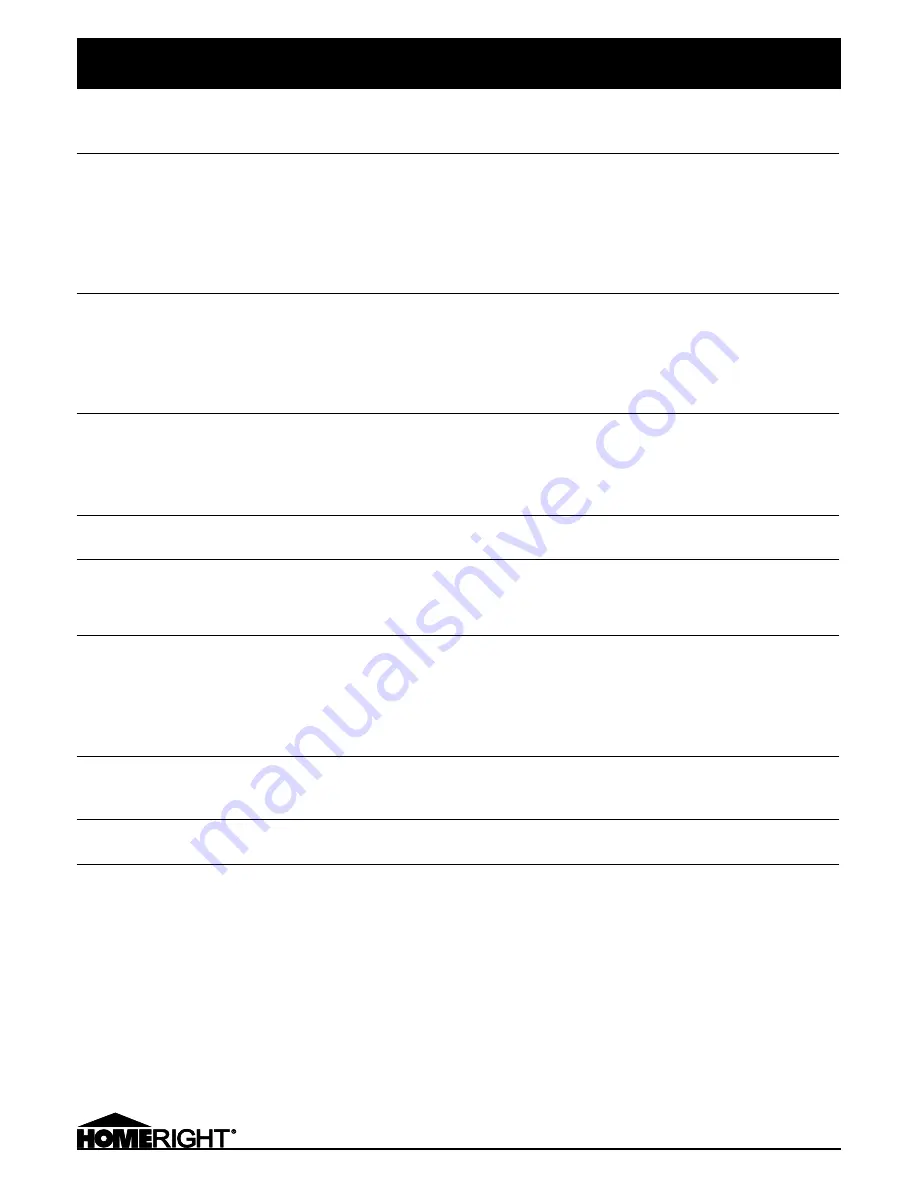
9
FINISH MAX
®
FINE FINISH SPRAYER
(C800766)
ENGLISH
9
FINISH MAX
®
FINE FINISH SPRAYER
(C800766)
ENGLISH
TROUBLESHOOTING
PROBLEM
CAUSE
REMEDY
Sags or runs
A. Too much paint.
B. Gun moving to slowly.
C. Paint too thin.
D. Gun held at incorrect angle or too close to painting
surface.
E. Spray overlaps too much.
A. Turn paint control knob counterclockwise.
B. Move gun faster.
C. Add unthinned paint to achieve correct time through
viscosity test cup.
D. Hold gun at right angle to the painting surface at a
distance of 4-10 inches.
E. Overlap spray by approximately 1/3 width of spray
pattern.
Dry spray
A. Insufficient paint coming from the spray gun.
B. Gun held too far from surface.
C. Overspray from a preceding section when gun
is not held at right angle to painting surface.
D. Spray patterns not well overlapped.
A. Turn paint control knob clockwise.
B. Hold gun at a distance of 4-10 inches or closer for small
objects.
C. Hold gun at right angle to the painting surface.
D. Overlap spray by approximately 1/3 width of spray
pattern.
Striped or uneven coverage
A. Gun tilted or not held at right angle to painting surface.
B. Dirt or burrs on air-cap or paint tip cause heavy top and
bottom pattern
C. Spray patterns not well overlapped.
A. Hold the gun at right angles to painting surface.
B. Clean or replace air-cap or paint tip.
C. Overlap spray by approximately 1/3 width of spray
pattern.
Spitting or spraying lumps
A. Solid particles in paint
B. Loose paint tube.
A. Strain paint.
B. Ensure paint tube is firmly pushed into place.
Weak or no spray
A. Low volume of paint from container due to blocked air
passageway in spray gun body. (Figure E, Page 9)
B. Paint not thin enough.
C. Lid washer missing/dirty
A. Clean passageway (3 mm vent holes in the container lid).
B. Add the appropriate amount of solvent to the paint. Add
only a small amount of solvent to the paint at one time.
C. Replace/clean lid washer
Top-or bottom-heavy pattern or
heavy right or left side pattern
A. Air cap holes partially blocked.
B. Obstruction on paint tip or dirt on air cap seat
or paint tip seat.
A. Determine if obstruction is on air cap or paint tip by
making a test pattern, rotating air cap half turn, and
spraying another test pattern. If defect is inverted,
obstruction is on air cap.
B. Clean air cap with non-metallic instrument. If obstruction
is on paint tip, check for fine burring which can be
removed with 600 wet or dry sandpaper. For dried paint
inside, open and wash.
Fluttering spray
A. Lack of paint.
B. Blocked paint passages.
C. Damaged paint nozzle or needle.
A. Refill container.
B. Clean.
C. Clean needle set or replace if necessary.
Paint leaking from guide nut
A. Loose guide nut.
B. Worn guide washer.
A. Tighten guide nut.
B. Replace guide washer.
Paint leaking from front
of gun.
Needle not seated properly due to:
A. Worn or damaged paint nozzle.
B. Dirt or dried paint in nozzle.
C. Guide washer too tight preventing needle
from seating.
D. Broken spring.
E. Scored or damaged needle.
A. Replace nozzle.
B. Clean nozzle.
C. Loosen guide washer.
D. Replace spring.
E. Replace needle.










































